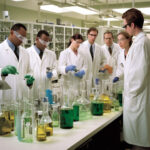Microbes from the Wild Help Scientists Craft Plastic That Melts Back Into Nature
In a world where plastic pollution has become a pressing environmental concern, scientists are constantly seeking innovative solutions to combat this global issue. One such groundbreaking solution comes from the collaboration between researchers at Murdoch University and a team of scientists who have developed a new bioplastic that completely disappears, leaving zero environmental impact.
Traditional plastics, derived from fossil fuels, have inundated our planet with non-biodegradable waste that takes hundreds of years to decompose. However, the bioplastic created by these scientists offers a ray of hope in the fight against plastic pollution. By harnessing the power of microbes found in the wild, they have crafted a material that can melt back into nature without leaving behind harmful residues.
This innovative bioplastic is designed to mimic the natural process of decomposition, where microorganisms break down the material into organic compounds. Unlike conventional plastics that persist in the environment long after their intended use, this new bioplastic offers a sustainable alternative that aligns with the principles of a circular economy.
The key to this bioplastic’s success lies in the unique combination of biodegradable polymers and enzymes that enable it to be broken down efficiently by microbial activity. By leveraging the natural capabilities of these microbes, the scientists have unlocked a solution that addresses the end-of-life challenges posed by traditional plastics.
Beyond its biodegradability, this new bioplastic also boasts impressive mechanical properties that make it suitable for a wide range of applications. From packaging materials to disposable cutlery, the versatility of this material offers a promising alternative to petroleum-based plastics.
Moreover, the production process for this bioplastic is relatively sustainable, requiring fewer resources and generating lower carbon emissions compared to traditional plastic manufacturing. This aspect not only reduces the environmental footprint of the material but also contributes to the overall goal of achieving a more eco-friendly industry.
As the demand for sustainable materials continues to rise, innovations like this bioplastic highlight the importance of integrating nature-inspired solutions into our technological advancements. By harnessing the power of natural processes, scientists can pave the way for a more harmonious relationship between human innovation and environmental preservation.
In conclusion, the development of a bioplastic that melts back into nature with the help of wild microbes represents a significant step forward in the quest for sustainable materials. With its ability to biodegrade completely and its versatile applications, this innovative material holds promise for reducing the environmental impact of plastic waste. By embracing nature-inspired solutions, we can work towards a greener future where innovation and sustainability go hand in hand.
#bioplastic, #wildmicrobes, #sustainablematerials, #plasticpollution, #environmentalinnovation












